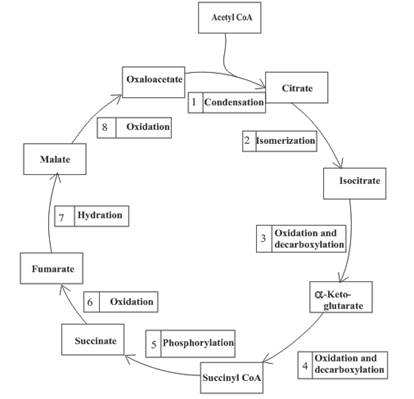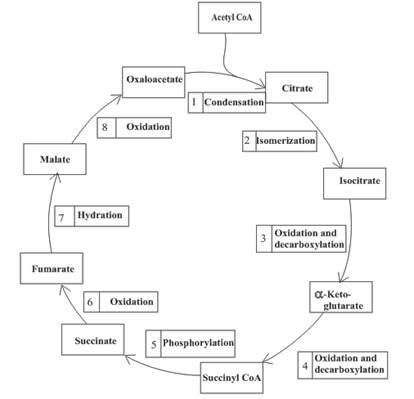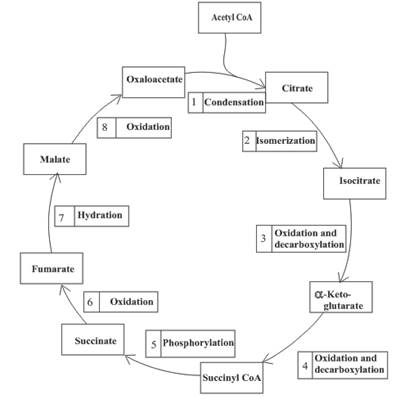
Concept explainers
(a)
Interpretation: To determine the two citric acid cycle intermediates involved in the reaction governed by an enzyme
Concept introduction: Citric acid cycle is the third stage of the biochemical energy production process. The cycle includes the reactions in which the acetyl part of acetyl CoA is oxidized and leads to the formation of carbon dioxide and

Enzymes are the biological molecules that are used to accelerate the
(b)
Interpretation: To determine the two citric acid cycle intermediates involved in the reaction governed by enzyme succinate dehydrogenase.
Concept introduction: Citric acid cycle is the third stage of the biochemical energy production process. The cycle includes the reactions in which the acetyl part of acetyl CoA is oxidized and leads to the formation of carbon dioxide and
An overview of the citric acid cycle is as follows:

Enzymes are the biological molecules that are used to accelerate the rate of the reaction. They are required for completion of various functions of the body.
(c)
Interpretation: To determine the two citric acid cycle intermediates involved in the reaction governed by enzyme citrate synthase.
Concept introduction: Citric acid cycle is the third stage of the biochemical energy production process. The cycle includes the reactions in which the acetyl part of acetyl CoA is oxidized and leads to the formation of carbon dioxide and

Enzymes are the biological molecules that are used to accelerate the rate of the reaction. They are required for completion of various functions of the body.
(d)
Interpretation: To determine the two citric acid cycle intermediates involved in the reaction governed by enzyme
Concept introduction: Citric acid cycle is the third stage of the biochemical energy production process. The cycle includes the reactions in which the acetyl part of acetyl CoA is oxidized and leads to the formation of carbon dioxide and

Enzymes are the biological molecules that are used to accelerate the rate of the reaction. They are required for completion of various functions of the body.
Want to see the full answer?
Check out a sample textbook solution
Chapter 23 Solutions
EBK GENERAL, ORGANIC, AND BIOLOGICAL CH
- Helicobacter pylori, which causes gastric ulcers, does not operate a citric acid cycle but contains many of the citric acid cycle enzymes. H. pylori can convert oxaloacetate to succinate for biosynthetic processes. Write an equation for this conversion.arrow_forwardidentify the reactions of the citric acid cycle that provide reducing power for the electron-transport chain a. conversion of succinyl-CoA to succinate b. conversion of fumarate to malate c. conversion of succinate to fumarate d. conversion of malate to oxaloacetatearrow_forwardIdentify different types of organic reaction mechanism (SN1, SN2, etc.) and reaction types (Addition, elimination, etc ) in the following metabolic pathways. 1. Conversion of Pyruvate to Acetyl CoA 2. Citric acid cycle 3. Gluconeogenesis pathway (pyruvate to glucose)arrow_forward
- Match the description with the correct enzyme : A. Glucose 6-phosphate dehydrogenase Serves a as a direct link between citric acid cycle and electron transport chain B. Succinate dehydrogenase v Uses alpha-keto carboxylic acid as a substrate C. Alcohol dehydrogenase Does not contribute electron carriers to oxidative phosphorylation D. NADH dehydrogenase E. Isocitrate dehydrogenase F. Pyruvate dehydrogenase complexarrow_forwardIf 14CO2 (radioactive carbon) were incorporated into the TCA cycle via the Pyruvate Carboxylase reaction which of the following molecules would contain radioactive carbon? a. Oxaloacetate b. Citric Acid c. Isocitrate d. Alpha-ketoglutarate e. Succinyl-CoA f .Succinate g. Fumarate h. Malatearrow_forwardExplain why the hydrolysis of the following compounds releases energy. A. phosphoenol pyruvate B. 1,3-diphosphoglycerate C. succinyl CoAarrow_forward
- Fatty acids are converted to their coenzyme A esters in a reversible reaction catalyzed by acyl-CoA synthetase: R-COO +ATP +COA R-C-COA +AMP + PPi a) The reaction involves two steps the first of which forms an enzyme-bound intermediate identified as the mixed anhydride of the fatty acid and AMP: R-C-O-P-O-nibose-adenine Write two chemical equations coresponding to the two steps of the reaction catalyzed by the synthetase. b) The acyl-CoA synthetase reaction as written above is readily reversible. How might the reaction be made to favor formation of fatty acyl-CoA? Write within the box. Anything outside the box will not be graded. From thearrow_forwardMalonate competes with succinate in the succinate dehydrogenase reaction. Explain why increasing the oxaloacetate concentration can overcome malonate inhibition.arrow_forwardsuccinyl-COA synthetase will do which of the following: Select one: a. Fumarate is combined with water to become Malate b. alpha-ketoglutarate is oxidized and decarboxylated to produce Succinyl-CoA, Carbon dioxide and NADH c. Succinate is oxidized to become fumarate forming FADH2 d. Citrate is rearranged to become Isocitrate e. Malate is oxidized to become oxaloacetate forming NADH f. Pyruvate is decarboxylated to become acetyl-CoA producing NADH and Carbon dioxide g. Succinyl-CoA becomes Succinate and forms one ATP molecule and Coenzyme A-SH h. Oxaloacetate combines with the acetyl from acetyl-CoA to produce Citric acid(citrate) i. Isocitrate and then decarboxylated and oxidized to produce alpha-ketoglutarate, Carbon dioxide and NADHarrow_forward
- Match the item to each step in the Krebs Cycle. Write your answers on the Google Form. isocitrate f. Oxaloacetate a. b. succinate g. Sulfur NAD* h. a-ketoglutarate fumarate C. d. malate i. succinyl-CoA j. ATP e. What molecule combines with acetyl-CoA and then releases CoA? 66. What molecule is oxidized by NAD+ to become a 5- carbon compound? 67. What molecule is oxidized by NAD+ to become a 4- carbon compound? 68. 69. What 4-carbon molecule is formed when combined with COA? 70. What molecule is produced when CoA is released? 71. What molecule is formed when GTP is oxidized to form GDP? 72. What atom is the bridge that connects to CoA? 73. What molecule is formed when FAD is reduced? 74. What molecule is formed with the addition of H,O? 75. Which molecule must be reduced so that oxaloacetate is formed? Match the product to the process. Write your answer on the Google Form. GTP f. CO, а. b. phosphofructinase NADH* + CO, g. Citrate formed. c. h. ATP d. Co-A i. Isocitrate HO j- Pyruvate e.…arrow_forwardThe citric acid cycle is shown. The methyl carbon in acetyl CoA is labeled with C14C14 (shown in red). Identify which of the carbons in each intermediate will be labeled in the first round of the cycle by selecting the indicated carbon(s). Each question has multiple options, answering with only one option is incorrect. Which carbon(s) in α‑ketoglutarate will contain C14? 1 2 3 4 5 Which carbon(s) in succinyl‑CoA will contain C14? 1 2 3 4 Which carbon(s) in succinate will contain C14? 1 2 3 4 Which carbon(s) in fumarate will contain C14? 1 2 3 4 Which carbon(s) in malate will contain C14? 1 2 3 4 Which carbon(s) in oxaloacetate will contain C14? 1 2 3 4arrow_forwardWhat four allosteric enzymes or enzyme complexes are responsible for the regulation of the citric acid cycle? Select all that apply. Malate dehydrogenase Fumarase Succinyl CoA synthetase Aconitase a-ketogluatarate dehydrogenase Succinate dehydrogenase Pyruvate dehydrogenase Citrate synthase Isocitrate dehydrogenasearrow_forward
 Human Anatomy & Physiology (11th Edition)BiologyISBN:9780134580999Author:Elaine N. Marieb, Katja N. HoehnPublisher:PEARSON
Human Anatomy & Physiology (11th Edition)BiologyISBN:9780134580999Author:Elaine N. Marieb, Katja N. HoehnPublisher:PEARSON Biology 2eBiologyISBN:9781947172517Author:Matthew Douglas, Jung Choi, Mary Ann ClarkPublisher:OpenStax
Biology 2eBiologyISBN:9781947172517Author:Matthew Douglas, Jung Choi, Mary Ann ClarkPublisher:OpenStax Anatomy & PhysiologyBiologyISBN:9781259398629Author:McKinley, Michael P., O'loughlin, Valerie Dean, Bidle, Theresa StouterPublisher:Mcgraw Hill Education,
Anatomy & PhysiologyBiologyISBN:9781259398629Author:McKinley, Michael P., O'loughlin, Valerie Dean, Bidle, Theresa StouterPublisher:Mcgraw Hill Education, Molecular Biology of the Cell (Sixth Edition)BiologyISBN:9780815344322Author:Bruce Alberts, Alexander D. Johnson, Julian Lewis, David Morgan, Martin Raff, Keith Roberts, Peter WalterPublisher:W. W. Norton & Company
Molecular Biology of the Cell (Sixth Edition)BiologyISBN:9780815344322Author:Bruce Alberts, Alexander D. Johnson, Julian Lewis, David Morgan, Martin Raff, Keith Roberts, Peter WalterPublisher:W. W. Norton & Company Laboratory Manual For Human Anatomy & PhysiologyBiologyISBN:9781260159363Author:Martin, Terry R., Prentice-craver, CynthiaPublisher:McGraw-Hill Publishing Co.
Laboratory Manual For Human Anatomy & PhysiologyBiologyISBN:9781260159363Author:Martin, Terry R., Prentice-craver, CynthiaPublisher:McGraw-Hill Publishing Co. Inquiry Into Life (16th Edition)BiologyISBN:9781260231700Author:Sylvia S. Mader, Michael WindelspechtPublisher:McGraw Hill Education
Inquiry Into Life (16th Edition)BiologyISBN:9781260231700Author:Sylvia S. Mader, Michael WindelspechtPublisher:McGraw Hill Education





